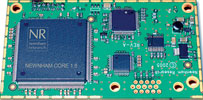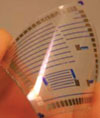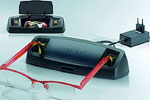
Southern Africa
Altech ISIS has agreed to acquire, for an undisclosed sum, MobiMaster, a specialist telecommunications realtime converged (pre- and post-paid) billing system provider business from French company, Linedata Services. The acquisition represents an on-going concern that includes the purchase and transfer of the telecoms billing intellectual property rights (IPR), together with all MobiMaster staff and customer contracts. It will now be incorporated under the Altech ISIS banner. The MobiMaster product complements Altech's existing iCAP products, offering realtime customer care, service request management/trouble ticketing, provisioning, administration, work flow and business rule management functionality. Its flexible billing functionality can also be offered to non-telecommunications environments, according to Altech. Through the acquisition, the company says that it gains access to telecoms markets in French-speaking countries and will have a presence in France to service the EMEA region. Altech ISIS currently has telecommunications customers in South Africa, Tanzania, Democratic Republic of Congo and Nigeria.
Sentech has signed a commercial cooperation agreement with GlobeCast Africa enabling programme satellite linking to and from anywhere in the world. The agreement will give Sentech access to a host of programme linking platforms from five continents, including news, entertainment, sports and coverage on events of global importance. In turn, GlobeCast will have access to feeds from South Africa, taking them to the rest of the world. GlobeCast is a global content management and content delivery company.
Belden CDT EMEA, a manufacturer and marketer of a broad range of cabling and connectivity components and structured cabling systems, has announced a new partnership between DataNet Distribution and Belden CDT. DataNet is now authorised to sell the Belden IBDN Certified Structured Cabling System in the African market. As an official distributor, DataNet will work closely with Belden's network of certified system vendors, who sell and install Belden IBDN end-to-end certified structured cabling systems in accordance with applicable guidelines.
Electrocomp has announced that as of April 2006 it has the rights to sell products from passives supplier, Murata. The company also offers development tools, which assist with S parameters and general design.
CCTV systems technology specialist, Protoclea Advanced Image Engineering, has won a third prison surveillance upgrading contract worth about R400 000 for the design, manufacture and supply of a digital on-line surveillance system operating 110 cameras. Replacing the original VCR-based system at Empangeni Prison in northern KwaZulu-Natal, it incorporates seven digital image recorders each with 16 channels and 1,6 terabytes of image storage capacity. The system was installed by KZN electronic systems installer and integrator, Cato Ridge Electrical Contracting. The requirements for the system were determined by Tsepa Consulting Engineers of Johannesburg. Protoclea Advanced Image Engineering (formerly Thales Advanced Engineering) has also designed and supplied digital CCTV surveillance systems that are assisting with security at Malmesbury Prison near Wellington in the Boland, and at Goodwood Prison in Cape Town.
Comtest, distributor of Fluke Industrial and Electrical test tools in southern Africa, has relocated to new larger offices in Midrand: Howick Mews (Ground floor), Mahai Close, Waterfall Business Park, Midrand, Gauteng. Tel: +27 (0)11 254 2200; fax: +27 (0)11 805 4706.
Overseas
Business
Intel posted first-quarter net income of $1,3 bn on revenue of $8,9 bn, down significantly on both a sequential and year-to-year basis. The company cited slumping PC sales and inventory troubles as the main culprits. For Q1, Intel earned $1,3 bn, down 45% from Q4 of 2005, and down 38% from Q1 of 2005. Revenue of $8,9 bn was down 5% from Q1 of 2005, and down 12% from Q4 of 2005. For 2006, Intel is now projecting revenue to be down approximately 3% from 2005. Intel originally said it expected 2006 sales to rise 6% to 9% from 2005.
Intersil reported first-quarter net income of $32,4m on sales of $178,9m, compared to $12,8m on sales of $128,1m in the year-ago quarter. Intersil reported gross margins of 57,0%, up from 55,0% in the year-ago quarter and 56,5% the previous quarter. By end market, Intersil's sales breakdown was 28% computing, 25% industrial, 25% high-end consumer, and 22% communications.
Freescale Semiconductor's sales in the first quarter of 2006 were $1,53 bn, compared to $1,48 bn in the fourth quarter of 2005 and $1,44 bn in the first quarter of 2005, significantly beating Wall Street estimates.
Companies
Electronic manufacturing services provider Flextronics International, has signed a definitive agreement to sell its software development and solutions business to an affiliate of Kohlberg Kravis Roberts & Co. (KKR), in a transaction valued at $900m. The transaction is the continuation of Flextronics' previously-announced strategy of focusing on the re-acceleration of significant growth opportunities in its core EMS business, which includes design, vertically-integrated manufacturing services, components and logistics. Last year Flextronics sold its semiconductor business to AMI Semiconductor.
Level 3 Communications has offered $163m in cash and stock to buy broadband carrier, ICG Communications of Colorado, USA.
Mimix Broadband, a supplier of microwave gallium arsenide (GaAs) semiconductors, has executed a definitive agreement to sell its gallium arsenide foundry to Universal Semiconductor Technology (USTI), a high technology investment company. The agreement allows Mimix to become completely fabless, while continuing to provide customers with its unique device intellectual property.
ON Semiconductor has announced that its primary operating subsidiary, Semiconductor Components Industries, has carried out a definitive agreement with LSI Logic to purchase LSI Logic's wafer fabrication facility in Gresham, and certain other semiconductor manufacturing equipment for a total of approximately $105m.
Andrew has acquired Precision Antennas, a Stratford, England-based provider of antennas for terrestrial and satellite communications systems for approximately $26m. Precision Antennas designs and produces microwave antennas for use in carrying point-to-point radio signals, as well as couplers and earth station antennas.
Broadband and optical products supplier JDS Uniphase has agreed to acquire Test-Um, a provider of home networking test instruments for the FTTx and digital cable markets. Test-Um offers a range of home-wiring test instruments for the verification, installation and maintenance of Category 3 and 5, and coaxial cables used in home and small office networks for the delivery of VoIP, IPTV and other services.
International Rectifier has announced that it is exploring the potential sale of all the company's 'non-focus' products business, including both its 'non-aligned products' and 'commodity products' segments. It said its non-focus products are not considered to be aligned with the company's long-term objectives or do not meet its gross margin and revenue growth targets. The company previously announced plans to de-emphasise its commodity business and accelerate the transition to high-performance analog, mixed-signal, and digital ICs and advanced-circuit products. These products, in its 'focus products' group, contributed 77% of revenues in the most recently reported quarter.
Surrey Satellite Technology (SSTL) has begun partnering with BAE Systems' Space Systems and Electronics unit to bring the UK technology firm's small satellite technology and processes to the US market. Under a memorandum of agreement the two companies will offer customers - particularly NASA and the Department of Defense - a broad range of small satellite capabilities, affordably and at low risk, according to BAE Systems.
Following their recent contract win for development of the WiMAX Forum's 802.16e protocol conformance test solution, Aeroflex and Cetecom Spain have now outlined the roadmap for the product's planned development and introduction. Initial discussions with technology partners are underway, all of whom will benefit from early access to the technology. Intended to cut WiMAX device development costs through a defined certification process, the Aeroflex/Cetecom WiMAX 802.16e protocol conformance test solution (MINT 2230 series) will provide development, pre- and full-conformance testing of both subscriber and base station equipment.
Digital radio chip and module specialist Frontier Silicon, has teamed with Swedish company Factum Electronics to develop and supply broadcasters with complete systems for mobile TV and digital radio using the T-DMB standard.
Maxwell Technologies has formed a toll manufacturing alliance with Belton Technology, a major Chinese manufacturer of precision components, flex circuits, circuit boards and other products, to produce Maxwell's Boostcap ultracapacitors and multicell modules. The alliance enables the company to tap into Belton's large existing factories, supply chain operations and production workforce to keep pace with the rapidly escalating ultracapacitor demand expected.
The Indus Entrepreneurs (TiE), a Silicon Valley-based not-for-profit global organisation, has launched the Semiconductor Special Interest Group (Semi SIG) in Hyderabad, India.
Semikron and STMicroelectronics are teaming up to develop and deliver integrated power modules for industrial, consumer, and automotive markets, embedding ST's power devices in Semikron's Semitop power packages. Under the agreement the two companies will combine their complementary competences to offer robust and cost-effective power solutions and use the new module range to expand their respective market coverage. They said the collaboration creates new opportunities for traditional power devices (IGBTs, power MOSFETs), as well as for ST's proprietary emitter-switched bipolar transistor devices, to offer both high voltage capability and high switching frequencies.
Zinc Matrix Power has received a $7m investment to continue moving its new high-energy, silver-zinc battery technology towards full-scale production for military and consumer electronics applications. Investors include Intel Capital, OnPoint Technologies and a large private equity group. The company claims its rechargeable silver-zinc batteries have demonstrated twice the energy-to-volume of current lithium-ion notebook computer batteries.
Industry
Market analyst Gartner has reported that worldwide semiconductor revenue reached a record $235 bn in 2005, surpassing the industry's previous high of $223 bn set in 2000. Semiconductor revenue increased 5,7% in 2005 from 2004. The final 2005 top 10 chip vendors were, in order: Intel, Samsung Electronics, Texas Instruments, Toshiba, STMicroelectronics, Renesas, Infineon, Philips, Hynix Semiconductor and NEC, according to the report. Personal computers and cellular telephones remain the largest drivers for semiconductor business, while the popularity of MP3 players, accounted for dramatic growth among flash memory vendors, noted Gartner.
Several recent reports from technical market research analyst firm In-Stat have demonstrated that non-voice services have been important in stabilising, and even increasing, monthly spending on wireless. A recent survey of mobile consumers revealed that, as expected, text messaging was the most commonly used non-voice service, followed by ringtones and picture messages. Relatively low penetration of other services suggests that there is substantial growth possible in this market, particularly as 3G networks and more-capable phones become available, it said.
Strategy Analytics' annual five-year outlook report for the gallium arsenide (GaAs) microelectronics industry, predicts that GaAs device revenues will grow by 36% over 2005 to 2010, breaking the $3 bn barrier in 2006. Overall market growth will continue to be derived from wireless markets, with cellular handsets as the primary driver, over the next five years, it says. New cellular handsets, which have multimode and multiband operational requirements, have added complexity that increases the GaAs device penetration in handsets.
The US Location-Based Services (LBS) business market is forecast to grow from 582 000 to 1,1 million subscribed devices by the end of 2010, reports In-Stat. Location-enabled enterprise applications constitute a small but important segment of the market for mobile IT applications. Applications for this technology include fleet management/dispatch, workforce and salesforce management, as well as a variety of public sector location applications. The largest market is legacy black box applications, which use vehicle-mounted devices. The use of cellular handsets equipped with assisted-clobal position system (A-GPS) chipsets is an emerging market.
Revenue growth for sales of MEMS (micro-electromechanical systems) devices worldwide slowed dramatically in 2005, despite the fact that unit shipments were very strong, reports In-Stat. Nearly 1,8 billion MEMS devices were shipped in 2005, generating revenues of just under $7 bn. In-Stat projects that the 'automotive and computing' segments, long mainstays of the MEMS industry in terms of both unit shipments and revenues, will be displaced by the 'communications and industrial' markets within the next five years.
Hard disk drive shipments increased by a record 23% for 2005 compared to 2004, according to market research firm iSuppli. This growth was driven primarily by the mobile PC and consumer electronics such as devices like MP3 players, Personal Media players, and digital video recorders. While iSuppli expects demand to remain strong, the possibility exists for problems such as overproduction, rapid changes in the growth rates of average areal densities, increasing competitive pressure from Flash memory, and lengthening times to market.
In-Stat is offering a free downloadable presentation 'Semiconductor myths - the truth about future semiconductor demand' that explores the misconceptions put forth in two myths prevalent concerning future semiconductor demand: that demand is slowing (due to maturation in the PC market, saturation in the cell phone market and consolidation among vendors), and that there is a need for a 'killer application'. In-Stat (www.in-stat.com) says it believes these myths are 'just about as real as the Easter Bunny' and expects growth for four out of the next five years, and that there will not be a single killer application, but rather market inflection points that will drive this market.
Iceland has supplanted South Korea as the country with the highest concentration of broadband users, recording 26,7 broadband users per 100, according to a broadband survey by the OECD. 30 OECD countries were surveyed. Although the US recorded the largest total number of broadband subscribers with 49 million, it only makes 12th place on the list.
Technology
Tired of ugly fluorescent tubes? Imagine your ceiling - or any surface - as a giant light panel, thanks to OLED research from the University of Southern California and Princeton University. Researchers there are claiming a major breakthrough in organic light emitting diodes (OLED) for use as a flat, energy efficient natural light source, which could have a significant impact on the way homes and offices are lit. Since OLEDs are transparent when turned off, the devices could even be installed as windows or skylights, say the researchers.
Fabless Cambridge-based semiconductor company Newnham has launched a high-performance graphics system that connects monitors to PCs over USB 2.0. The USB NIVO is intended to allow any number of monitors to be connected to a single PC and also enables them to display different content. It comprises Windows XP software on the host computer and a hardware module that includes a hardware rendering engine that is connected to or can be embedded in a monitor. The solution is said to be compatible with all CRT and flat panel monitors with screen resolutions up to 1280 by 1024 pixels at 75 Hz.

Swedish firm Thin Film Electronics has shown an electronic memory device entirely manufactured by industrial scale inkjet printing techniques and equipment. The work is carried out in collaboration with Xaar, a Cambridge manufacturer of inkjet printheads. This breakthrough demonstrates the feasibility of using inkjet printing methods for manufacturing electronic devices. With real printed electronics evolving (currently at an R&D stage), the companies are now adding a non-volatile random access memory as well as a manufacturing technology, to this rapidly-growing field.

Samsung Electronics claims it has developed a three-dimensional (3D) chip-packaging technology, based on a proprietary wafer-level stack process (WSP). WSP technology uses 'through silicon via' interconnections to enable a range of small, hybrid packages. The company's first 3D package consists of a 16 Gbit memory solution, which stacks eight 2 Gbit NAND chips in the same unit and is only 0,56 mm in height. According to the company, the technology is a much smaller version of today's' multichip packages (MCPs).
IBM has developed a new technology designed to greatly increase the chip security of consumer, medical and defence products and systems. Dubbed 'SecureBlue' the encryption technology is said to be suitable for hard wiring into the core of any kind of processor. Because it is based on secure hardware rather than software techniques, the company says it provides strong protection for secrets and strong defences against reverse-engineering and tampering. By providing the overlaying 'on-chip' security layer, SecureBlue removes a major barrier to the widespread use of crypto-based strong protection.
Dutch company Varibel has launched a hearing aid in the form of a pair of glasses. Microphones, signal processing and miniature speakers are all contained in the arms of the frames. Originally developed at Delft University of Technology, Varibel developed the glasses into a consumer product in partnership with Royal Philips Electronics. Embedded in each leg of the frame, is a row of four tiny interconnected microphones, which selectively intensify the sounds that come from the front, while dampening the surrounding noise. The result, according to the company, is a directional sensitivity of +8,2 dB, which compares to a regular hearing aids' dir. sensitivity of +4 dB.

© Technews Publishing (Pty) Ltd | All Rights Reserved